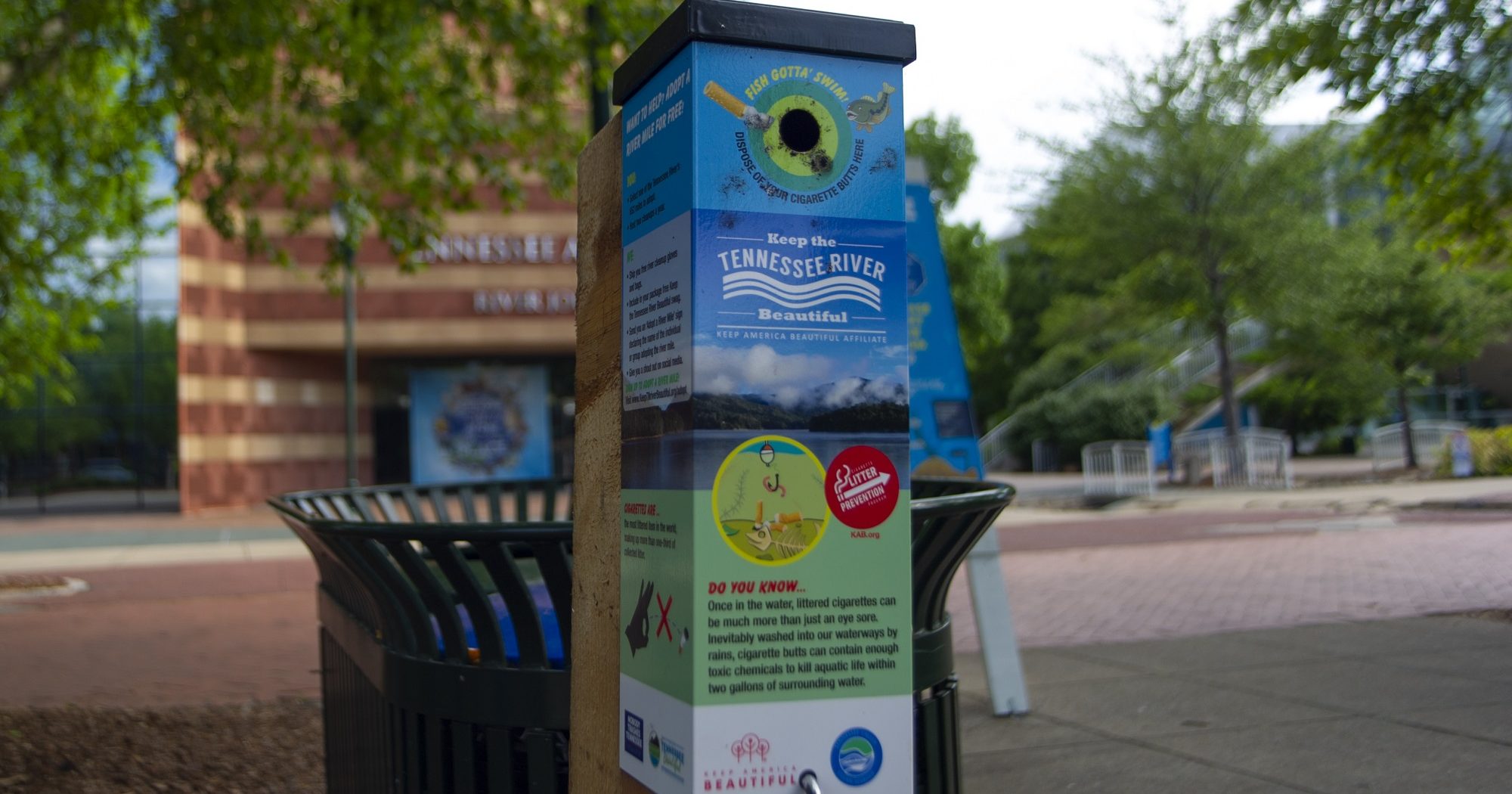Chattanooga, Tenn. (May 20, 2021) – Pick a city street — any street — and take a look around. Chances are you’ll see a smattering of cigarette butts dotting the ground like the tracks of an animal with a serious overpopulation problem.
Because of their ubiquity, these white and orange filters can seem to almost fade into the background, but many eventually find their way from streets, gutters and parking lots into nearby streams and rivers. Within months, they begin to break down, polluting the surrounding water with tiny plastic fibers and a devil’s cocktail of chemical compounds.
“The filters are designed to pull out toxins that people don’t want in their bodies when they’re consuming cigarettes, but the filters then carry those toxins into the riverways,” says Kathleen Gibi, executive director of Keep the Tennessee River Beautiful. “One cigarette filter can contain enough toxins to kill aquatic life within two gallons of surrounding water.”
Keep the Tennessee River Beautiful is an affiliate of the national nonprofit Keep America Beautiful and the first whose sole focus is on a river. Its mission is to inspire the public to take action to protect and preserve the Tennessee River and its tributaries across a seven-state region encompassing Tennessee, Georgia, Alabama, Kentucky, Mississippi, North Carolina and Virginia.
Cigarettes butts are the most littered item in the world. Every year, estimates place the number of discarded cigarettes at 4-6 trillion, an amount capable of poisoning the equivalent of 12-18 million Olympic swimming pools of water.
In an effort to provide a safe, clean means of ensuring that cigarette butts stay out of the Tennessee River watershed, Keep the Tennessee River Beautiful and the Tennessee Aquarium have partnered to install special cigarette butt recycling receptacles on the aquarium’s campus. Eight of these clearly marked bins have been placed in heavily trafficked locations.
“Everybody contributes to the river, whether positively or negatively, so finding stakeholders and inspiring them to take action is what will make the biggest impact,” Gibi says. “The Aquarium does a great service for the river by educating the entire region about the importance of caring for our waterways, but now also by directly preventing those cigarette butts from being washed into the river.”
The Aquarium’s eight bins join more than 480 that Keep the Tennessee River Beautiful has installed within the Tennessee River watershed with another 90 are scheduled to be installed the coming months. Dollywood is among the 73 sites where the bins have been installed, making it the first theme park in the world that recycles all the cigarette butts it collects, Gibi says.
Partnering to remove cigarette filters from the river is in sync with the Aquarium’s ongoing mission to understand the impact on freshwater habitats from microplastic pollution.
“The benefit of being the Tennessee Aquarium is having the ability to reach hundreds of thousands of visitors and social media users each year so that we can inspire personal change from the discoveries we make,” says Dr. Anna George, the Aquarium’s vice president of conservation science and education. “It’s really urgent to understand better ways to manufacture and dispose of plastics so we reduce their impact on the environment.
“As all humans need access to clean water, it’s an incredibly important treasure to protect.”
In 2017, the Tennessee Aquarium Conservation Institute worked in concert with German professor and scientist Dr. Andreas Fath during Tenneswim, a monthlong effort to swim the length of the Tennessee River. During the 34-day “swim for science,” Fath conducted daily analyses of water quality indicators, including concentrations of microplastics. The findings of Tenneswim revealed levels of microplastics 80 times higher than in Germany’s Rhine River, where Fath conducted a similar study in 2014. The scientist theorized that much of this waterborne microplastic was carried into the river from land-based sources.
In September 2020, the Tennessee Aquarium Conservation Institute and the University of Georgia River Basin Center convened a digital gathering of 50 researchers conducting pioneering studies into microplastics’ impact on freshwater systems.
Thanks to a new exhibit in the River Journey building, guests visiting the Aquarium can now see for themselves how microscopic pieces of plastic can have a big impact on freshwater habitats. The new exhibit was funded by a grant from the Tennessee Department of Transportation in support of its Nobody Trashes Tennessee litter reduction campaign. By waving their hands over a touchless sensor, visitors activate a vortex in a water-filled receptacle. As the water spins, floating pieces of plastic at the surface spread to fill the entire tank.
For more information about Keep the Tennessee River Beautiful, visit keeptnriverbeautiful.org/mission.
To learn more about the Tennessee Aquarium Conservation Institute and its work, visit tnaqua.org/conserve/
